Centauri Dreams
Imagining and Planning Interstellar Exploration
Red Dwarf UV: Too Little to Spark Life?
We’re going to need a lot more information about the effects of ultraviolet light as we begin assessing the possibility of life on the planets of red dwarf stars. We already know that young red dwarfs in particular can throw flares at UV wavelengths that can damage planetary atmospheres. They can also complicate our search for biosignatures through processes like the photodissociation of water vapor into hydrogen and oxygen, a non-biological source of oxygen of the kind we have to rule out before we can draw even tentative conclusions about life.
Could flares have astrobiological benefits as well? That’s a question that emerges from a new paper from Sukrit Ranjan (Harvard-Smithsonian Center for Astrophysics) and colleagues. What concerns Ranjan’s team is that red dwarf stars may not emit enough ultraviolet to benefit early forms of life. On the primitive Earth, UV may have played a key role in the formation of ribonucleic acid. If this is the case, then UV flare activity could actually help red dwarf planets by compensating for the lower levels of UV red dwarfs produce when they are quiescent.
“We still have a lot of work to do in the laboratory and elsewhere to determine how factors, including UV, play into the question of life,” said co-author Dimitar Sasselov, also of the CfA. “Also, we need to determine whether life can form at much lower UV levels than we experience here on Earth.”

Image: This artist’s impression shows how the surface of a planet orbiting a red dwarf star may appear. The planet is in the habitable zone so liquid water exists. However, low levels of ultraviolet radiation from the star have prevented or severely impeded chemical processes thought to be required for life to emerge. This causes the planet to be devoid of life. M. Weiss/CfA
But back for a moment to the question of UV and the early Earth. As the authors show in their paper, UV can power up prebiotic photochemistry. The literature on this is diverse and includes discussions of UV in relation to the origin of chirality, the synthesis of amino acid precursors and the polymerization of RNA. We can draw some inferences from RNA and DNA themselves, as the paper notes:
Measurements of nucleobase photostability suggest that the biogenic nucleobases (the informational components of the RNA and DNA monomers) are exceptionally stable to UV irradiation compared to structurally similar molecules with comparable thermal properties, suggesting they evolved in a UV-rich environment (Rios & Tor 2013; Beckstead et al. 2016; Pollum et al. 2016). This scenario is consistent with our understanding of conditions on prebiotic Earth: UV light is thought to have been abundant on young Earth due to the absence of a biogenic ozone layer (Cockell 2000a,b; Ranjan & Sasselov 2016).
Recent work by Ranjan and Sasselov has explored the interaction between UV radiation and prebiotic chemistry to the point that the authors now argue such interactions will be an important consideration as we try to understand the surface environment of planets orbiting red dwarfs. If correct, the hypothesis could give us a new criterion for assessing planetary habitability.
These matters are significant because the first atmospheres of planets in their stars’ habitable zones that we will be able to analyze will be found around stars like TRAPPIST-1, LHS 1140 and, of course, Proxima Centauri, the closest red dwarf of all. The figures for UV radiation are striking, with the authors estimating that prebiotic Earth-analog planets would experience between 100 and 1000 times less UV than would have been available on the early Earth.
“It may be a matter of finding the sweet spot,” said co-author Robin Wordsworth of the Harvard School of Engineering and Applied Science. “There needs to be enough ultraviolet light to trigger the formation of life, but not so much that it erodes and removes the planet’s atmosphere.”
If the key question for future laboratory work is whether UV levels this low can support life’s formation, we’re still forced to cope with the fact that we have only one known instance of abiogenesis. And even here on Earth, the question of exactly how life emerged remains the subject of debate. It is not inconceivable that we might find signs of life on a red dwarf planet that emerged along entirely different lines than the life that appeared on our own.
This is interesting stuff, because in most papers treating the question of UV on red dwarf planets, the radiation is considered a negative for habitability. A large amount of work has gone into analyzing whether various mechanisms exist that could protect surface life from UV flares, everything from biofluorescence to ozone layers and oceans. But if we exclude very active young stars, the authors argue, non-flare UV experienced at the surface of habitable zone planets could be clement for life. The question becomes, is it strong enough for life to begin?
The authors’ concern:
…uncertainty over whether the UV-dependent prebiotic pathways that may have led to the origin of life on Earth could function on planets orbiting M-dwarfs, such as the recently-discovered habitable zone planets orbiting Proxima Centauri, LHS 1140, and TRAPPIST-1. Even if the pathways proceed, their reaction rates will likely be orders of magnitude lower than for planets around Sunlike stars, potentially slowing abiogenesis.
Thus the paper calls for laboratory work measuring the reaction rate of UV-dependent prebiotic pathways, and analyzing their susceptibility to changes in radiation level. If we learn that red dwarf planets do not receive sufficient radiation at these wavelengths, then we may want to turn our attention to the more active red dwarfs, whose frequent flares can power photochemistry.
The paper is Ranjan, Wordsworth and Sasselov, “The Surface UV Environment on Planets Orbiting M-Dwarfs: Implications for Prebiotic Chemistry & Need for Experimental Follow-Up,” Astrophysical Journal Vol. 843, No. 11 (10 July 2017). Abstract / preprint.

Water Loss Prospects at TRAPPIST-1
We’re going to eventually get to know the seven planets of the TRAPPIST-1 system well. That’s because they present the ideal targets for upcoming attempts to probe the atmospheres of Earth-sized rocky planets. Orbiting an M-dwarf some 39 light years out, all seven of the planets here transit. Because of the faintness of their star and the size of the planets themselves, they present excellent candidates for transit spectroscopy, in which we look at the light from the star through planetary atmospheres to deduce their constituents.
Using the Space Telescope Imaging Spectrograph on the Hubble instrument, an international team led by Vincent Bourrier (Observatoire de l’Université de Genève) has been studying the ultraviolet radiation received by each of the planets in the system. The more we know about the star’s output, the more we can plug values into the atmospheric escape processes that can occur in its planets, with huge consequences for surface conditions. The team in particular was looking for the signature of an extended atmosphere for TRAPPIST-1 c.
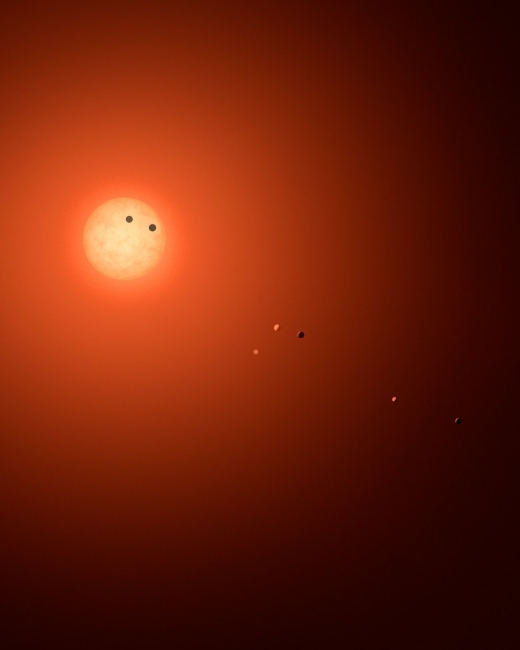
Image: This is an artist’s impression of the TRAPPIST-1 system, showcasing all seven planets in various phases. When a planet transits across the disk of the red dwarf host star, as two of the planets here are shown to do, it creates a dip in the star’s light that can be detected from Earth. During such transits astronomers are able to study the potential atmospheres of these planets. Credit: NASA.
How would such an atmosphere be found? Low-energy ultraviolet radiation can break down water molecules, producing oxygen and hydrogen — the process is known as photo-dissociation. By heating the upper atmosphere, stronger ultraviolet (XUV) radiation as well as X-rays can play a role in letting the hydrogen and oxygen escape into space.
We wind up with hydrogen that can theoretically be detected in the exosphere of the planet, which can be seen as a possible marker for water vapor in the atmosphere. We’ve had hints in earlier transits of planets b and c, also studied by Bourrier, that “could either indicate extended atmospheres of neutral hydrogen or intrinsic stellar variability.” The current work, however, was unable to detect a hydrogen exosphere during a transit of c. We may still be able to find such hydrogen in future observations with the James Webb Space Telescope.
In the absence of such a detection, this paper focuses on the irradiation of the star and the wide range of consequences for water on its planets. We learn that the amount of ultraviolet radiation TRAPPIST-1 is putting out could lead to significant water loss over the history of the system. Based on their measurements, the researchers arrive at an estimate of present XUV radiation and go on to calculate the possible water loss.
This gets interesting because it covers the entire planetary system and describes markedly different rates of water loss. From the paper:
With our current knowledge of the TRAPPIST-1 system, the major uncertainty on the water loss estimates comes from the uncertainty on the planet masses, rather than on the XUV luminosity. Setting the masses to their nominal estimates from Gillon et al. (2017) we found that planets g and closer-in could have lost more than 20 Earth oceans through hydrodynamic escape, if the system is as old as 8 Gyr. Planets b, c, and possibly d could still be in a runaway phase, but if water loss drops down significantly within and beyond the HZ, planets e, f, g, and h might have lost less than 3 Earth oceans.
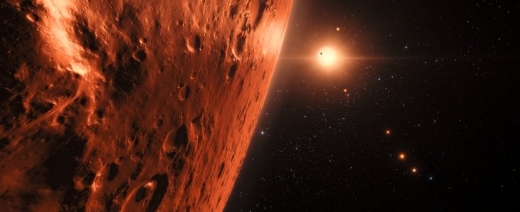
Image: This artist’s impression shows the view from the surface of one of the planets in the TRAPPIST-1 system. At least seven planets orbit this ultracool dwarf star 40 light-years from Earth and they are all roughly the same size as the Earth. Several of the planets are at the right distances from their star for liquid water to exist on the surfaces. Credit: ESO/N. Bartmann / spaceengine.org.
We would expect planets b and c, the two innermost worlds, to have the highest water loss over the eight billion years this system has been in existence, but it’s notable that planets e, f and g — the three thought to be in the habitable zone — could have lost a good deal less. That would imply the possibility that these perhaps temperate worlds still have water on their surfaces.
The authors point out that their estimates of water loss should be considered as upper limits, because their assumptions probably maximize the rate of the XUV interaction with the atmosphere. All planets except TRAPPIST-1 b and c could, they argue, harbor significant amounts of water, perhaps aided by outgassing, depending on planet formation models that include water content. But this is a tough calculation, and it depends on mass:
The amount of water outgassed after a few hundred Myr (after which TRAPPIST-1 h to e, and possibly d, have entered the HZ), is greater for planets with more massive refractory parent bodies. Improving our constraints on the planet masses of the TRAPPIST-1 system will therefore significantly improve our understanding of the variable outgassing capabilities of the TRAPPIST-1 planets and hence the current state of their atmospheres.
Are there other physical mechanisms that could affect the loss of atmospheres and, possibly, their replenishing? Other gases might slow the outflow, while stellar flares could increase it. On flares, however, Bourrier and team note that they observed no flaring activity in their observations at X-ray and far ultraviolet wavelengths, while earlier observations in the optical and infrared have shown a low rate of flares, with weak flares every few days but stronger flares once every two to three months, a rate the authors consider low.
We also have to take into account the possible effects of the stellar wind from TRAPPIST-1, which can likewise erode atmospheres, especially in the earlier phases of the system’s evolution. Our lack of knowledge of possible magnetic fields, which can affect the rate of atmospheric loss, is due to our lack of information about the composition and structure of the planets here. No wonder, then, that Bourrier is careful about his assessment:
“While our results suggest that the outer planets are the best candidates to search for water with the upcoming James Webb Space Telescope, they also highlight the need for theoretical studies and complementary observations at all wavelengths to determine the nature of the TRAPPIST-1 planets and their potential habitability.”
So much depends on JWST, which may be able to nail down our estimates on any hydrogen exospheres in TRAPPIST-1 planets. The paper is Bourrier et al., “Temporal evolution of the high-energy irradiation and water content of TRAPPIST-1 exoplanets,” accepted at the Astronomical Journal (preprint).

New Activity of Repeating FRB 121102
Andrew Siemion, who heads up the Breakthrough Listen initiative and is director of the Berkeley SETI Research Center, sent out a message to astronomers on August 29 noting recent activity from the radio source FRB 121102. The heightened activity had been noted by Breakthrough Listen postdoctoral researcher Vishal Gajjar. You’ll recall that Fast Radio Bursts (FRBs) are powerful but extremely short-duration radio pulses whose sources generally remain unknown.
What tags FRB 121102 as especially interesting is that it is the only FRB known to repeat. In fact, more than 150 bursts have been observed coming from the dwarf galaxy 3 billion light years from Earth that is thought to be its place of origin. And now we have heightened activity in the form of 15 new bursts, as the Astronomer’s Telegram notes:
These are the highest frequency and widest bandwidth detections of bursts from FRB 121102 obtained to-date. Additional fully calibrated full-Stokes analysis employing coherent dedispersion on raw voltage data is ongoing. These observations may indicate FRB 121102 is currently in a heightened activity state [Law et al. arXiv:1705.07553], and follow-on observations are encouraged, particularly at higher radio frequencies.
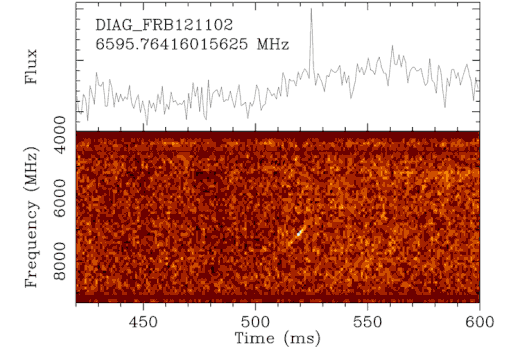
Image: A sequence of 14 of the 15 detected bursts illustrate their dispersed spectrum and extreme variability. The streaks across the colored energy plot are the bursts appearing at different times and different energies because of dispersion caused by 3 billion years of travel through intergalactic space. In the top frequency spectrum, the dispersion has been removed to show the 300 microsecond pulse spike. Capturing this diverse set of bursts was made possible by the broad bandwidth that can be processed by the Breakthrough Listen backend at the Green Bank Telescope. Credit: Breakthrough Listen.
Do FRBs mark the catastrophic end of some kind of astronomical object? If so, the fact that FRB 121102 repeats sets it apart from the rest. A rotating neutron star with an extremely strong magnetic field is also a possibility. There is also a SETI possibility: High-energy laser bursts from a distant civilization could be observable by us. Harvard’s Avi Loeb, working with Manasvi Lingam, discussed the prospects in a recent paper, working out their parameters in terms of engineering requirements if FRBs were indeed produced by an extraterrestrial civilization (see Fast Radio Bursts: Signature of Distant Technology?)
Vishal Gajjar used the Breakthrough Listen backend instrument at the Green Bank Telescope in West Virginia to observe the recent activity of FRB 121102. Says Gajjar:
“The extraordinary capabilities of the backend receiver, which is able to record several gigahertz of bandwidth at a time, split into billions of individual channels, enable a new view of the frequency spectrum of FRBs, and should shed additional light on the processes giving rise to FRB emission.”
Indeed. According to this UC Berkeley news release, the backend instrument accumulated 400 terabytes of data in a five hour period on Saturday, August 26, with observations extending across the 4 to 8 GHz frequency band. What the team was looking for were the signatures of short pulses with a dispersion — a delay as a function of the frequency — that is caused by gas between the source and the Earth. Remember that these beams have been traveling for a long time. As Berkeley astronomer Steve Croft notes, they left their host galaxy when life on our planet consisted of nothing more than single-celled organisms.
The current active state of FRB 121102 could prove quite useful, allowing us to measure this source of FRBs at the highest precision yet. The 15 new pulses Gajjar observed show emissions at higher frequencies than have previously been seen. The brightest FRB 121102 emission occurred around 7 GHz. We’re a long way from being able to figure out what causes FRBs, but the Breakthrough Listen instrumentation is giving us the best look at the frequency spectrum of this powerful source yet.
The results of this work will be presented in an upcoming paper. The paper exploring artificial origins for FRBs is Loeb and Lingam, “Fast Radio Bursts from Extragalactic Light Sails,” Astrophysical Journal Letters Volume 837, Number 2 (8 March 2017). Preprint) available.

Schedule for Cassini’s Final Days
The Jet Propulsion Laboratory has just published details about Cassini’s last days and its final plunge into Saturn on September 15. That last act turns the craft into our first planetary probe of Saturn, to use Linda Spilker’s memorable phrase. A Cassini project scientist at JPL, Spilker goes on to note that the probe will be “sampling Saturn’s atmosphere up until the last second. We’ll be sending data in near real time as we rush headlong into the atmosphere — it’s truly a first-of-its-kind event at Saturn.”
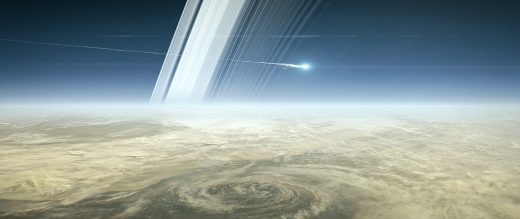
Image: Cassini streaks across Saturn’s sky in its final moments. Credit: NASA/JPL-Caltech.
I want to lift the Cassini final calendar out of this JPL news release, as many Centauri Dreams readers have expressed an interest particularly in the mission-ending atmospheric entry. We will likely lose radio contact within, JPL estimates, one to two minutes after the descent into the atmosphere begins. Eight of the twelve science instruments will be operating throughout the plunge, including the ion and neutral mass spectrometer (INMS), which will be sampling Saturn’s atmosphere. The imaging camera will be off during the descent.
The predicted time for loss of signal on Earth is 0754 EDT (1154 UTC) on September 15. JPL’s End of Mission Timeline is up and running, with a countdown clock and full schedule of events. The schedule below will probably be tweaked as we get closer to the final day, so keep checking the Timeline page as well as @CassiniSaturn on Twitter for updates.
Did you miss today’s preview of our #GrandFinale at Saturn? Catch the replay at: https://t.co/5adt2ODbgo pic.twitter.com/hFnqzg6miP
— CassiniSaturn (@CassiniSaturn) August 29, 2017
Here’s the schedule as it stands this morning:
- Sept. 9 Cassini will make the last of 22 passes between Saturn itself and its rings — closest approach is 1,044 miles (1,680 kilometers) above the clouds tops.
- Sept. 11 — Cassini will make a distant flyby of Saturn’s largest moon, Titan. Even though the spacecraft will be 73,974 miles (119,049 kilometers) away, the gravitational influence of the moon will slow down the spacecraft slightly as it speeds past. A few days later, instead of passing through the outermost fringes of Saturn’s atmosphere, Cassini will dive in too deep to survive the friction and heating.
- Sept. 14 — Cassini’s imaging cameras take their last look around the Saturn system, sending back pictures of moons Titan and Enceladus, the hexagon-shaped jet stream around the planet’s north pole, and features in the rings.
- Sept. 14 (5:45 p.m. EDT / 2:45 p.m. PDT) — Cassini turns its antenna to point at Earth, begins a communications link that will continue until end of mission, and sends back its final images and other data collected along the way.
- Sept. 15 (4:37 a.m. EDT / 1:37 a.m. PDT) — The “final plunge” begins. The spacecraft starts a 5-minute roll to position INMS for optimal sampling of the atmosphere, transmitting data in near real time from now to end of mission.
- Sept. 15 (7:53 a.m. EDT / 4:53 a.m. PDT) — Cassini enters Saturn’s atmosphere. Its thrusters fire at 10 percent of their capacity to maintain directional stability, enabling the spacecraft’s high-gain antenna to remain pointed at Earth and allowing continued transmission of data.
- Sept. 15 (7:54 a.m. EDT / 4:54 a.m. PDT) — Cassini’s thrusters are at 100 percent of capacity. Atmospheric forces overwhelm the thrusters’ capacity to maintain control of the spacecraft’s orientation, and the high-gain antenna loses its lock on Earth. At this moment, expected to occur about 940 miles (1,510 kilometers) above Saturn’s cloud tops, communication from the spacecraft will cease, and Cassini’s mission of exploration will have concluded. The spacecraft will break up like a meteor moments later.
By the JPL countdown clock, it’s just under 16 days to final signal received on Earth as I write this. It’s worth quoting Cassini project manager Earl Maize at this point:
“The end of Cassini’s mission will be a poignant moment, but a fitting and very necessary completion of an astonishing journey. The Grand Finale represents the culmination of a seven-year plan to use the spacecraft’s remaining resources in the most scientifically productive way possible. By safely disposing of the spacecraft in Saturn’s atmosphere, we avoid any possibility Cassini could impact one of Saturn’s moons somewhere down the road, keeping them pristine for future exploration.”
Cassini doesn’t have HAL’s AI smarts, but I keep thinking about the final burn Arthur C. Clarke’s famous computer gave to the Discovery in the film 2010: The Year We Make Contact. ‘Poignant’ only begins to explore the complex emotions I’m feeling as we prepare to lose this bird.

OSIRIS-REx: Course Correction Sets Up Gravity Assist
NASA’s OSIRIS-REx spacecraft, now on a two year outbound journey to the near-Earth asteroid Bennu, is a good deal closer to home than you might think. At play is a gravity assist maneuver that will take the craft past the Earth on September 22nd, propelling OSIRIS-REx into the orbital plane of its target. As of August 25th, the spacecraft was 16.6 million kilometers from the Earth.
Twenty-four days and a wake-up! You know I'm getting close when the one-way light time is under a minute.https://t.co/rACre4nDe4 pic.twitter.com/uvKBaNoqYM
— NASA's OSIRIS-REx (@OSIRISREx) August 28, 2017
The OSIRIS-REx team is reporting that a course adjustment burn was performed on August 23rd, a successful correction that marked the first time the spacecraft’s attitude control system (ACS) had been used in what is being called a ‘turn-burn-turn’ sequence. It’s a precision maneuver requiring the momentum wheels on OSIRIS-REx to turn the spacecraft so its thrusters are lined up for the burn. When the burn is complete, the momentum wheels turn the spacecraft back to its previous orientation. Thrust is monitored by an on-board accelerometer.
The maneuver on August 23rd lasted a scant 77 seconds, successfully changing the velocity of the spacecraft by 47.9 centimeters per second while using 0.46 kilogram of fuel. Precision work indeed, but just a warm-up for what will be needed at the asteroid, whose gravitational field is so weak that the smallest changes in velocity will allow exploration and mapping.
Its inclination adjusted — and there is the possibility of another Earth-targeting maneuver on September 12 if tracking data indicate it is necessary — OSIRIS-REx will begin its approach to Bennu in August of 2018, using its array of small rocket thrusters to perform a series of braking maneuvers, slowing the craft down by 0.53 kilometers per second. This will allow a relative approach velocity of about 20 cm/s, setting up a preliminary survey of Bennu in October of that year. At that point, the spacecraft will be essentially flying in formation with the asteroid.
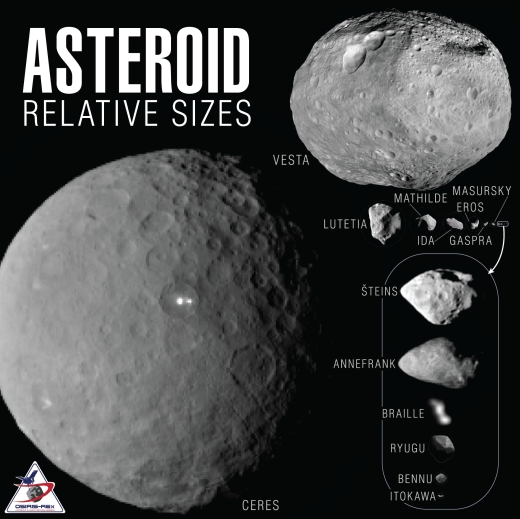
Image: Putting things into scale, this is a look at where the near-Earth asteroid Bennu fits in the asteroid catalog, a small object indeed toward the bottom of the chart. Credit: NASA/OSIRIS-REx team.
The survey of Bennu that begins after arrival in the fall of 2018 will last for a year, and will include four major phases:
- Preliminary Survey searches for asteroid plumes and natural satellites, and also measures the Yarkovsky acceleration of Bennu.
- Orbital A allows the Flight Dynamics Team to transition from star-based navigation to landmark-based navigation using images of Bennu’s surface.
- In Detailed Survey, several instruments work together to map Bennu and determine its global spectral, thermal, and geological properties.
- Orbital B continues to map Bennu at higher resolutions, with a focus on candidate sample sites. At the end of Orbital B a sample site will be selected.
That first item above is interesting. When working with asteroids, we have to take into account the Yarkovsky effect, which acts on rotating bodies in space and can be a significant influence on the the behavior of small asteroids. Daily heating of a rotating body in space can cause slow changes, producing a net force that causes a retrograde rotator like Bennu to gradually spiral inward toward the Sun. The effect has to be taken into account when calculating the object’s long-term trajectory, vital information for an Earth-crossing asteroid like this.
The OSIRIS-REx sample collection maneuver is to occur in July of 2020, when the craft makes a touch-and-go at a velocity of approximately 10 cm/s. Here the craft’s touch-and-go sample acquisition mechanism (TAGSAM) will be deployed, contacting the surface of Bennu for five seconds while releasing a burst of nitrogen gas that forces loose material into a collector. Up to three sampling attempts can be made, with a goal of 60 grams up to 2 kilograms of sample.
If all goes well, OSIRIS-REx will return its sample to Earth in September of 2023, jettisoning its sample return capsule (SRC) before performing a deflection maneuver to put the main craft into a stable orbit around the Sun. A soft landing in the Utah desert on September 24, 2023 is what mission planners are hoping for, and the chance for laboratory study of the asteroid’s chemical composition, including a search for organic compounds like amino acids and sugars.
Learning about Bennu’s physical properties will be helpful as we try to understand the distribution of molecular precursors to the origins of life on Earth. But it doesn’t hurt that we will also be learning a great deal about an object that itself has a faint chance of impacting the Earth late in the 22nd Century. A thorough knowledge of how it is made will help us understand how, if we ever have to do it, we will be able to adjust the trajectory of objects like these.
There is a useful mission overview and graphic timeline on the OSIRIS-REx site, which is likewise a good place to monitor mission developments. The mission’s Twitter account is @OSIRIS-REx.

Venus Automaton Design Recalls Mechanical Computers
I don’t usually talk about spacecraft close to our own Sun, but exceptions invariably arise. Centauri Dreams took a close look at the Parker Solar Probe back in June, because its operations close to the Sun (within about 10 solar radii) have implications for how we might build the kind of spacecraft that can perform ‘sundiver’ maneuvers, approaching the Sun before deploying a solar sail for maximum effect (see Parker Solar Probe: Implications for Sundiver). Sundivers are one way to maximize acceleration for future interstellar missions.
And then there’s Venus, a planet I’ve written little about in these pages. The Automaton Rover for Extreme Environments (AREE) concept study now being funded by the NASA Innovative Advanced Concepts program is intriguing because it looks at spacecraft design from a fresh angle, actually one that harkens back to generations of mechanical devices that have had little part in space exploration. At least, until now. For while the environment on Venus challenges all our surface rover concepts, a hybrid mechanical/electronic design might save the day. The implications for other extreme environments in the outer system are quite interesting.
AREE grows out of ideas first proposed in 2015 by JPL engineer Jonathan Sauder, who drew on his knowledge of mechanical computers, the sort of calculating machines that use levers and gears instead of microchips. Think of Charles Babbage’s Difference Engine, which was designed in the 19th Century, or the Greek Antikythera mechanism, which could tell the Hellenistic world in ancient times about upcoming astronomical events like eclipses.
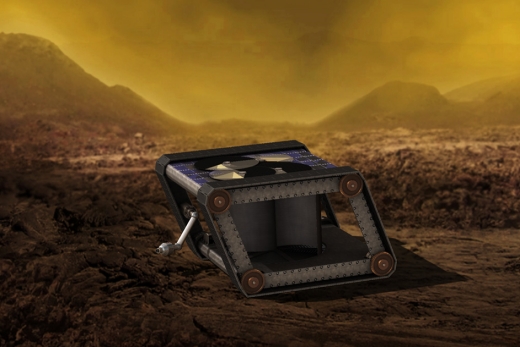
Image: AREE is a clockwork rover inspired by mechanical computers. A JPL team is studying how this kind of rover could explore extreme environments, like the surface of Venus. Credit: NASA/JPL-Caltech.
Sauder likes the idea of using analog technologies on Venus because electronics don’t last long under its extreme pressure and temperatures. If we can limit the use of electronics to the bare essentials and do the rest with analog techniques, we change the paradigm.
The power source? Wind turbines in the center of the rover, storing energy in a constant force spring. Tank treads, or something similar, would replace wheels, while communications would be handled by a rotating shutter placed in front of a bright radar target. The idea would be to turn the bright reflection on and off. Venus rover, meet the Royal Navy circa 1800 communicating with flags and signal lamps.
Build AREE right and you get long-duration in-situ mobility, a rover that might last on Venus’ hellish surface for a year or more (Soviet Veneras lasted for minutes or hours). Sauder considers it an automaton, ‘a mechanical device capable of performing a series of complex actions to achieve a specific result.’ I like the way AREE is described on this NIAC page:
[Automatons] have long been explored as art forms but remain unexplored for space applications. The automaton rover is designed to reduce requirements on electronics while requiring minimal human interaction and based on the subsumption architecture from robotics, where simple reactions of the rover lead to complex behavior. AREE combines steampunk with space exploration to enable science measurements unachievable with today’s space technology.
And the Phase 1 report notes: “High temperature electronics are incorporated where they have sufficient maturity and application, such as instrumentation.”
In other words, we are looking at a hybrid rover heavily dependent on mechanical methods but using electronics where needed. I hasten to add that this concept is maturing and may change substantially as a result of the Phase II work.
Consider the history of Venus exploration to see why alternate approaches are interesting. Venus’ surface reaches 460 degrees Celsius, hot enough to melt lead, while the surface pressures are high enough to crush the hull of a nuclear submarine at 90 bar. The Soviets attempted 14 landings in their Venera and Vega programs, nine of these being a success, but the sturdy probes lasted no more than two hours or so before being rendered inoperative.
“When you think of something as extreme as Venus, you want to think really out there,” said Evan Hilgemann, a JPL engineer working on high temperature designs for AREE. “It’s an environment we don’t know much about beyond what we’ve seen in Soviet-era images.”
The plan, then, is to bake mechanical prototypes of AREE to see how thermal expansion affects their moving parts. Phase 1 of the NIAC study compared mechanical rover technologies to electronics-based rovers using RTG cooling systems and designed to handle high temperatures, finding that current technologies were costly and not yet up to speed. The study also demonstrated the kind of passive signaling that would be deployed on AREE.
Phase II, now in progress, will set about finalizing the locomotion and signaling systems for the mechanical rover and creating a final rover design, a prototype that could perform initial testing. If AREE can work, it could change the game. One recent proposal for a Venus mission used a liquid gas cooling system that despite a price tag between $2 and $3 billion, could survive for less than a day on the surface. Sampling from multiple sites and developing longer-term weather data would be rendered impossible for this kind of device. AREE, with a sharply reduced electronics package, is a relatively low-cost mechanical alternative.
So we may one day be using levers and gears to produce calculations on this hellish world. We can only wonder what Charles Babbage might have made of the idea. Another reference is Pierre Jaquet-Droz, who along with his son produced mechanical automata in the 18th Century of extraordinary complexity. One of these, called The Writer, consisted of 6000 pieces, a mechanical boy with a primitive programmable memory who writes upon paper with real ink.
Mechanical computers experienced major growth in the early 1940s, and as Sauder’s Phase 1 report points out, were at their zenith by the 1940s. Nor were they simple affairs: They had gone from solving arithmetical problems to guiding bomb trajectories and aiming shipboard guns, taking atmospheric conditions into account. Sauder points to the Globus mechanical computer, an automaton that provided trajectory data for every Soviet launch until 2002. At the other end of the scale, mechanical watches and clocks can operate for decades — the oldest mechanical clock has been operated for 700 years. Throw in modern advances and we are now talking about a 10,000 year clock designed to function with minimal maintenance.
From the report:
Clever mechanisms can be combined with high temperature electronics to enable a platform that is more capable than either technology by itself. For example, one may consider simple addition. An electronic adder requires 576 transistors to combine two 16-bit numbers. To add numbers larger than 16 bits, multiple iterations through software would be required. However, a mechanical analog differential adder can solve the same problem using only 5 gears.
The goal, then, is to look critically at rover design to minimize the electronics package:
By finding these areas where mechanical solutions are relatively simple, the load on the computer can be reduced, thereby enabling a mission. Of course, a differential adder can only perform the adding operation, whereas a processor made up of many transistors can perform many other functions. But for an automaton, where the system is designed to carry out a specialized series of actions, this flexibility is not required.
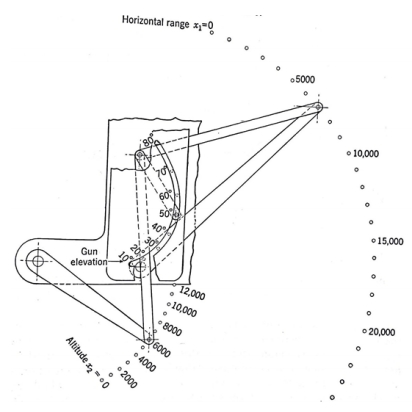
Image: Figure 9 from the Phase I report. A simple example of an analog mechanical computer with multiple inputs. Credit: Jonathan Sauder.
Note that the ability to make science measurements is what Sauder considers one of the greatest weaknesses of a purely mechanical system. We can think, then, of hybrid rovers in which electronics are reduced sharply in complexity by using mechanical analog systems where possible, but still deployed if necessary for high-resolution data. Back to the Phase I report:
Additional study is necessary to leverage the existing suite of high temperature electronics to make critical science measurements targeted towards the mission context. Furthermore, in the coming months it is expected several specific high temperature electronic technologies will be announced for further development through the Hot Tech program. The selection will define what scientific measurements will become the most relevant with soon to be released technology. Therefore, instead of focusing on instrument development, this [Phase 1] study focuses on developing a mobile platform for Venus and other extreme environments which could host various instrument payloads.
And now we move on to the Phase II study. A comeback for automata may prove useful not only on Venus but in any number of difficult environments where the data collection may be basic but persist for long periods of time. Operations near Jupiter, for example, produce significant radiation problems and demand extensive shielding for electronics, just as high pressure environments beneath planetary atmospheres (the interior of a gas giant) challenge the survivability of our best electronic probes. Venus could turn out to be an interesting test case for how we add mechanical methods into our toolkit of deep space exploration.
For more, see Sauder et al., “Automaton Rover for Extreme Environments,” NASA Innovative Advanced Concepts Phase 1 Final Report, available here.


